
Original Link: https://www.anandtech.com/show/2218
Introduction and Test Setup
Last week saw the announcement of the 8600 GTS, 8600 GT, and 8500 GT graphics cards from NVIDIA. We haven't yet gotten our hands on an 8500 GT, but we've added a few more performance tests in the meantime. A deeper look at the G84's video processing capabilities will also follow, as we have a working driver, player, and HD-DVD drive.
From a pure performance perspective, we were underwhelmed with the 8600 series. While there are cases where G84 performs well, such as in Oblivion and Rainbow Six, performance wasn't very impressive in other titles like Prey and Battlefield 2. With the two more intensive graphically intensive games showing more promise, we decided that further investigation was in order.
We have thrown two RTS and two more FPS games into the mix this time. Our lineup has filled out to include the very recent titles S.T.A.L.K.E.R. and Supreme Commander. We also have two returning titles in F.E.A.R. and Company of Heroes. Hopefully these additions will give us a better idea of where G84 stands.
Our test setup is nearly the same, but we have added one more graphics card to the mix: the Radeon X1900 XT 256MB. This card is a little older than the rest, but its price has fallen enough to put it in competition with the 8600 GTS. Of course, the X1900 XT 256MB might become harder to find as time goes on, and it doesn't support DX10 or offer 100% H.264 decode offloading. However, those who are only concerned with maximum performance in current games at a given price will certainly want the comparison to be made.
The only other difference is that we are now using the publicly available GeForce 8600 driver from NVIDIA's website. We still don't have an update for GeForce 7 users, in spite of the fact that the 8800 and 8600 hardware now shares a Windows XP driver.
| System Test Configuration | |
| CPU: | Intel Core 2 Extreme X6800 (2.93GHz/4MB) |
| Motherboard: | EVGA nForce 680i SLI |
| Chipset: | NVIDIA nForce 680i SLI |
| Chipset Drivers: | NVIDIA nForce 9.35 |
| Hard Disk: | Seagate 7200.7 160GB SATA |
| Memory: | Corsair XMS2 DDR2-800 4-4-4-12 (1GB x 2) |
| Video Card: | Various |
| Video Drivers: | ATI Catalyst 7.3 NVIDIA ForceWare 93.71 (G70) NVIDIA ForceWare 97.94 (G80) NVIDIA ForceWare 158.16 (8600) |
| Desktop Resolution: | 1280 x 800 - 32-bit @ 60Hz |
| OS: | Windows XP Professional SP2 |
Without any further ado, let's get right in to the performance tests.
Company of Heroes Performance
Company of Heroes includes a built-in performance test that consists of the cut scene prior to the first mission. We have found that the performance generally reflects in-game performance, although some of the larger firefights may run somewhat slower.
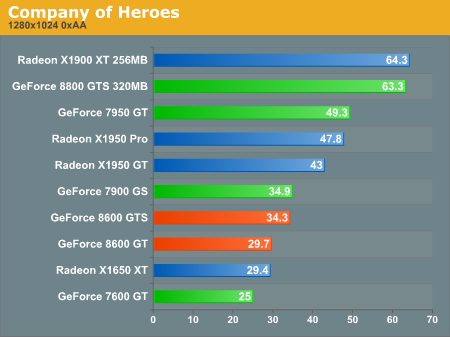
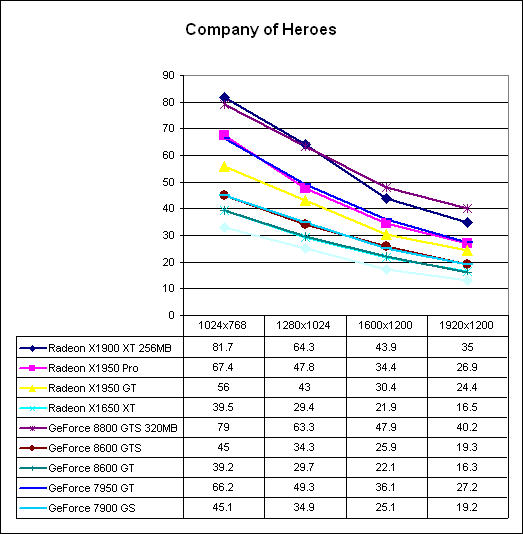
The quick and dirty summary is that the 8600 cards perform way lower than we'd like when running Company of Heroes. The 8600 GTS is able to match performance with the 7900 GS, and the 8600 GT keeps up with the X1650 XT. We are disappointed with the performance of G84 as compared to older hardware in this case. Features are great to add, but we need to see market leading price/performance at the introduction of new hardware. This launch feels more like a case of two steps forward, two steps back.
F.E.A.R. Performance
We use the built-in performance test in F.E.A.R. with all options set to maximum with the exception of soft shadows.
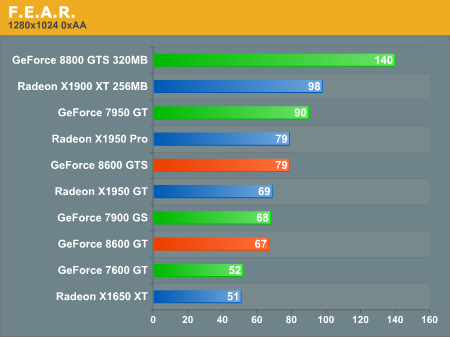

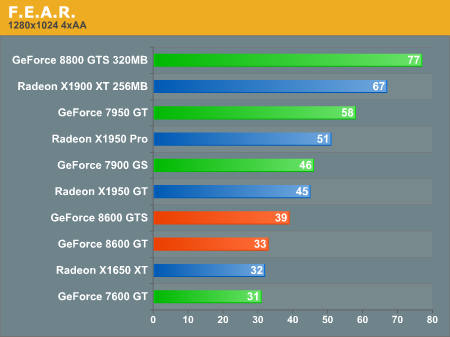
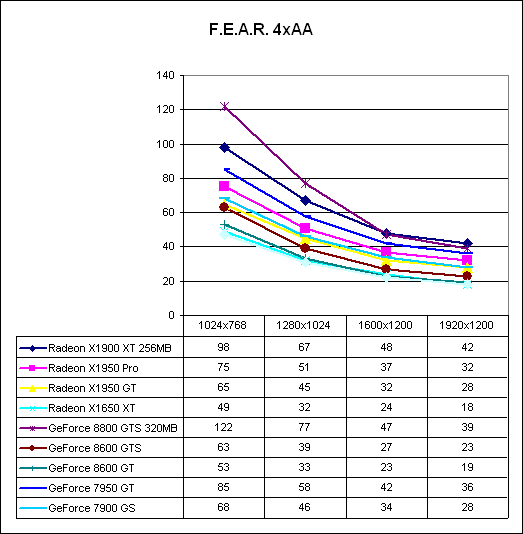
Once again, the 8600 GTS and 8600 GT are nowhere near top performers in their relative price segments. Enabling AA paints an even worse picture, putting performance in line with what we saw under Company of Heroes. F.E.A.R. is a fairly demanding game, but it is nothing new. We could possibly attribute poor performance to the fact that newer games will probably be more compute intensive and this may help our new G84 hardware out. That is, of course, if it weren't for our next test.
S.T.A.L.K.E.R. Performance
NVIDIA has been pushing this game since the GeForce FX days, and now it is finally here. We have to use FRAPS to benchmark it even though a demo_play feature is included. Apparently the demo_record facility had to be removed at the last minute.
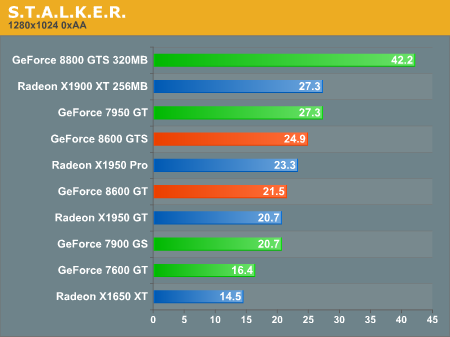
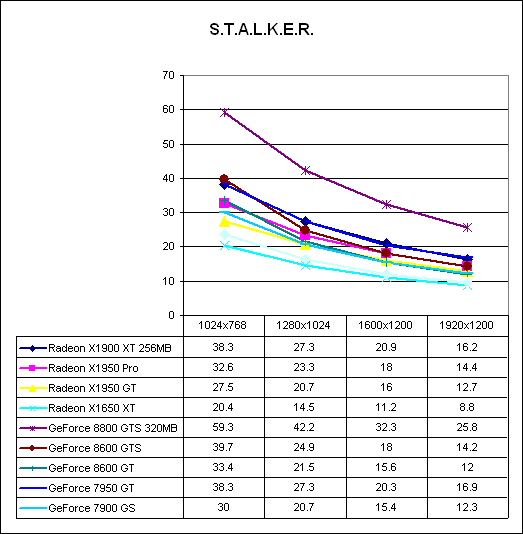
Interestingly, at 1024x768, both the 8600 GTS and 8600 GT perform well compared to their competitors. The 8600 GTS manages to beat the X1900 XT 256MB while the 8600 GT keeps up with the X1950 Pro. Unfortunately, the new hardware can't keep its lead beyond 1024x768, as moving up to 1280x1024 gives us a much sharper drop on G84 than on other hardware.
With the added texture address capability per shader and drastically reduced memory bandwidth compared to other 8 series hardware, the problems we are seeing could be related to memory pressure. This would also help to explain the poorer than expected performance in older games that rely more heavily on lots of textures rather than shader speed. We would need to do many more synthetic tests to really get to the bottom of this issue though.
At 1280x1024, a resolution many midrange gamers run, the new 8600 series just isn't able to handle S.T.A.L.K.E.R. with all the settings turned up except grass shadows. Some settings will need to be lowered a bit to achieve better performance at higher than 1024x768.
Supreme Commander Performance
This is the first time we've included Supreme Commander in our graphics benchmarks as well. There is a built-in performance test accessible by appending /perf to the command line. This performance test is quite long, so we edited the script (Gas Powered Games uses lua scripting) to skip over one or two of the longer battles. This way we still have a four or five minute test scenario that pushes graphics pretty hard. This test was run with all the graphics settings turned all the way up, and the framerate is fine for gameplay at 1280x1024 on both our 8600 cards. Getting up to 1600x1200 and beyond is pushing the limits though, and settings my need to be decreased.
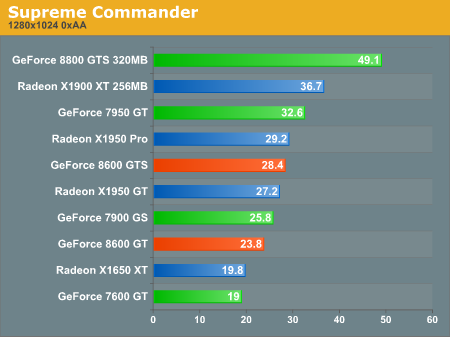
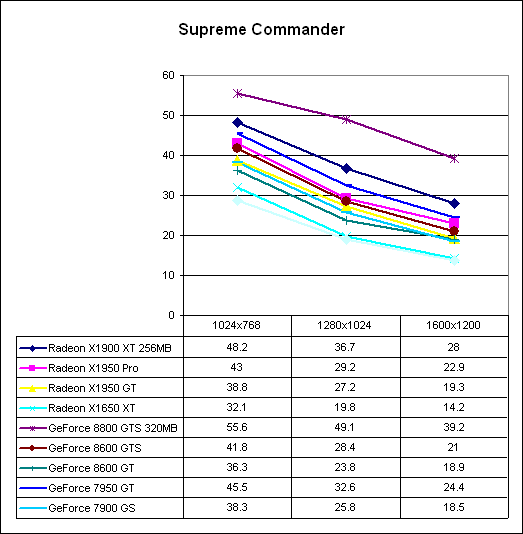
The 8600 GT only beats the X1650 XT and the 7600 GT, which is not where we would like to see performance. As for the 8600 GTS, it leads the X1950 GT and 7900 GS, but this still means the 8600 GTS comes in last in its price class losing to the X1950 Pro, 7950 GT, and X1900 XT 256MB.
Final Words
With the past few generations of midrange $150 cards, we've come to expect that current games could more or less be played with maximum settings at lower mainstream resolutions. This is somewhat the case with the 8600 series. With some of the titles we tested, we had to dial down the settings a bit more to get a smooth experience at 1280x1024. Taken on its own, this isn't a major issue.
The new G84 based midrange solutions offer DX10, which no other midrange hardware currently supports. We also get better video decode performance with 100% decode acceleration of H.264 video. If this was where the story ended, we would be quite happy with the new hardware from NVIDIA, but there is a larger context to consider.
NVIDIA's GeForce 8600 GTS and GT simply do not perform any better than similarly priced hardware from AMD. GeForce 7 Series hardware priced at $150 and $200 also performs similarly to G84 based parts, outperforming the newcomer in some games and tying or trailing in others. Certainly NVIDIA can determine the value of their hardware as they see fit, and they have a good argument for pricing the 8600 series. Other hardware at the $150 and $200 price points perform similarly, so their new hardware is mostly worth the price.
The problem is that there is a huge performance gap between the 8600 GTS and the 8800 GTS 320MB. We also have multiple cases where NVIDIA's new offerings perform lower than similarly priced hardware from their own previous generation hardware. In almost every case, AMD's X1900 XT 256MB beats out the 8600 GTS. While this hardware is certainly being phased out, it is still available and offers much better price/performance.
The bottom line is that the 8600 really doesn't offer what we would expect from a next generation midrange part. While on its own the 8600 series is not bad hardware, NVIDIA needs to rely on more than its feature set to sell its product. This is especially true when DX10 games are not abundant and fairly few people are even running an operating system which supports DX10.
The GeForce 6600 GT outperformed the Radeon 9800 Pro in virtually every benchmark, sometimes by large margins. It managed this with prices that were at the time quite a bit lower than the previous generation's champ. GeForce 7600 GT was also typically faster than GeForce 6800 GT/GS, and it once again came with a lower price tag. The 8600 hardware on the other hand doesn't appear significantly faster or cheaper than the cards it's replacing..
Even if we can't expect new hardware at a particular price point to blow away the competition, we would at least like to see a consistently better performance than similarly priced previous generation hardware. Our follow up benchmarks confirm that we simply don't get this from the 8600 series. For users who want the highest performance for their money, the 8600 series is not the answer. If you can live without full H.264 decoding support and you still want DirectX 10, the 8800 GTS 320 is currently so much faster than the 8600 GTS that we would recommend spending the extra ~$75.
At the same time, we wouldn't recommend against the 8600 series, as it does provide best in class video decode performance that will enable more computer owners to experience HD content without dropping frames. While DX10 software isn't really available yet, we can't ignore the fact that this hardware does support DX10. Whether or not it will achieve acceptable frame rates with DX10 software remains to be seen, but if DX10 games turn out similar to Oblivion and R6: Vegas, there's still hope. Performance isn't low enough on the 8600 hardware to completely pan the product, but we are at present unimpressed.







